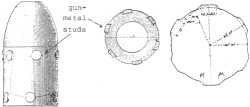The Gun - Rifled Ordnance: Reversion to muzzle-loadersAn Ordnance Select Committee sat in 1863 '...to consider the relative merits of muzzle-loading and breech-loading equipments...' but in 1864 - before they had concluded their investigation - the Government stopped the manufacture of Armstrong RBL guns. On 18 August 1865 the Committee reported thus: "The many-grooved system of rifling with its lead-coated projectiles and complicated (!) breech-loading arrangements is far inferior for the general purpose of war to the muzzle-loading system and has the disadvantage of being more expensive in both original cost and ammunition. Muzzle-loading guns are far superior to breech-loaders in simplicity of construction and efficiency in this respect for active service; they can be loaded and worked with perfect ease and abundant rapidity." The die-hards had won! However, the Committee did admit that the Armstrong system of gun construction, although expensive, was without doubt the safest. And Armstrong was quick to point out that while it was not uncommon for cast iron muzzle-loading guns to burst in action often with fatal casualties, not one Armstrong gun had ever burst. There had been minor mishaps, and a few injured, but not one man had been killed. In 1866 the Committee began further tests and actually showed they were becoming alive to the advantages of breech-loading. They submitted a comprehensive report which included remarks on two very important aspects. Breech-loading gave
Unfortunately cost seemed to dominate all other factors. Having been brainwashed by a parsimonious Government, the Committee announced, 'The balance of advantages is in favour of ML field guns'. Gunner safety ran a bad second. Yet another committee (!) which deliberated in 1870 declared '... the majority of Royal Artillery Officers were convinced that no system of breech-loading artillery was necessary in the field'. The Director of Artillery backed them up, and news that the breech mechanisms of 200 Krupp guns had failed during the Franco-Prussian War further hardened the opposition to breech-loading. On the other hand the Germans did not give up so easily; they persevered with their breech mechanisms and overcame their defects. Their reward was a head start in the armament race about to begin. Whatever may have been its faults the Armstrong had demonstrated in no uncertain manner the superiority of rifled ordnance over smooth-bored, but strangely many Officers still stubbornly insisted rifling was unnecessary. Some even saw it as a handicap. The following anecdote will serve to illustrate their beliefs: Sir Andrew Noble (1831 - 1915), who contributed greatly to the progress of gunnery, in trying to convince an eminent artillery Officer that rifled guns were more accurate than smooth-bored, drew a diagram showing that shot from a rifled gun fell into a much smaller area (the 100% zone) than those from a smooth-bore. 'That only proves what I have always maintained', relied the eminent Gunner. 'Our smooth-bore is the best in the world. With your new-fangled gun firing at me I have only to keep outside that small area and I shan't be touched. But with the smooth-bore firing at me I'm not safe anywhere!" This argument apparently floored Sir Andrew! ImprovisationDuring the introduction of the RBL guns, what to do with the large stocks of cast iron smooth-bore pieces presented a problem to defence authorities. Despite the Crimean War experience in which the bursting of Lancaster guns cast doubt on the suitability of the metal for rifled ordnance, they still hoped some other system might work. In 1859 an Ordnance Select Committee commenced a series of tests on cast iron 32-prs (6.375-inch) guns. Those tested included one from each of the inventors above and rifled according to their design. To ensure uniformity all guns were cast by the same firm and from the same batch of metal. A gun rifled on the system designed in 1842 by Colonel Treuille de Beaulieu of the French Army, which had adopted it in 1856, was also tested, but with the number of grooves reduced from six to three. The Committee eventually decided to adopt the three-groove version for the RML system about to be introduced as it proved the most accurate and the easiest to load. They thereupon dubbed it 'The Woolwich System'.
WL Ruffell, 1998 previous | index | next | History index | Home |
